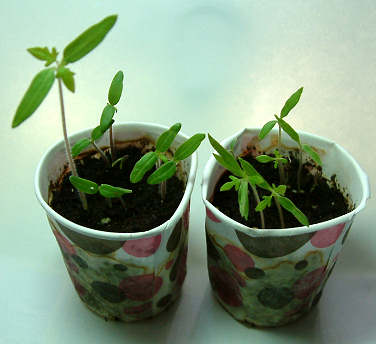Tomato Growing Tips
These tomato growing tips are for inexpensive ways to stretch your gardening budget. After all, part of the reason for gardening is so you pay less for vine-ripe tomatoes! Not to mention the deliciousness of homegrown tomatoes. 😀
There’s a book out on the $64 tomato, where a gardener says that after he tallied up all his costs associated with his tomato plants, and divided it among the tomatoes harvested, it came to something like $64 a tomato.
No, it doesn’t cost that much! I haven’t read the book, and I’m sure part is tongue-in-cheek. But it is true that if you don’t watch it, you, too can be spending a whole lot more than you intended.
Tip #1: Household Items
Some of the household items I like using include used (washed) pantyhose; cut them in wide strips and you can use them for tying up the tomatoes to their stakes.
Small 3-ounce Dixie cups are fantastic for germinating tomato seeds and really inexpensive (especially if you get the store brands).
Gallon containers like plastic milk jugs and tea jugs are great for mixing up fish and seaweed emulsion fertilizer drenches. Just remember to label the containers with their new ingredients! Two liter bottles are fine as well.
All kinds of household plastic and waxed paper containers can be used for temporary potting, before setting out in the garden. Just make sure to punch holes for drainage.
Tips For Fertilizers and Soil Amendments
Most fertilizers have a high nitrogen component, which is not what you want for tomato fruits! And most fertilizer instructions want you to apply them far too often. If you have enriched your garden soil with compost or composted manure, you will need far less fertilizer. I generally apply my fertilizer at half the strength suggested on the label instructions with good results.
If you have the room, set up a compost pile. depending on your climate it can take anywhere from a month to a year for finished compost, but your tomatoes will thank you. And since compost is made from food scraps you’d normally throw away, it’s a great way to recycle.
If you live in an area with cows or horses, see if you can arrange to cart away some of the manure; normally you can get your manure free this way — put it in your compost pile to make it even richer.
OK, what if you don’t have room for a compost pile (or you just don’t want one). Go to your local garden center and find a fertilizer which can be diluted before applying to the plants. One small box of Miracle Gro is pretty inexpensive (I like Miracle Gro for Roses) and lasts quite awhile.
Thoughts on Garden Equipment
If you have a small garden (100 square feet or less), try renting a tiller for a day or two instead of buying one. If, however, you have a larger garden, buying your own tiller may make sense for the long run.
A shovel, spade, hoe and pitchfork are really all the hand tools you need. The pitchfork is optional, and mainly used if you have a compost pile.
You can make your own tomato cages from concrete reinforcing wire; useful if you have a lot of tomatoes that need staking as they do seem to last forever. Rebar makes for good tomato stakes, if you have easy access to it. But if you have only a couple-three plants, you can use commercial tomato towers and cages and save yourself the trouble. I’ve found that most commercial cages/towers last quite a few years and tend to be easier to store.
Don’t have a lot of room for a garden? I’ve found the 5-gallon grow bags are great for medium-sized indeterminate tomato plants and are pretty inexpensive. You can go as small as 3-gallon for smaller and determinate tomatoes, and 10-gallon for the larger indeterminates.
Plants Versus Seeds
Hands down, it’s cheaper to plant seeds than buy tomato plants. Some of the best-producing tomato varieties may not be available as plants in your area. For $3, you can grow 20 to 40 plants from seeds…or you can buy one plant.
Keep in mind that if you store them in a cool, dry place, your tomato seeds will be good for several years. So if you don’t plant the whole pack this year, you automatically have seeds available for next (and the next…)!
Now it’s true that if you plant seeds you need to get some seed-starting soil; you don’t want to use anything from the garden, as it will have bacteria that may cause problems. But you’ll use very little per seed; a small 4-quart bag can be used for many, many dozens of seeds. Around here, the big-box garden centers (Home Depot, Lowe’s, etc.) carries the small bag for between $4 and $5.
You will also need a germination tray or two, but they are also inexpensive and last year after year. I had one windowsill mini-greenhouse that finally bit the dust…after 10 years.
Final Tomato Growing Tips
You really don’t need to spend a fortune to grow your tomatoes; household items will suffice in many situations, and other more permanent items (shovels, cages, etc.) will last many years if you treat them properly.
Not all tomato varieties produce the same number of fruits. Cherry tomatoes are far and away the most prolific! In general, the larger the tomato fruit size, the fewer the tomatoes produced. The heart-shaped tomatoes as a group tend to produce the least. For a continuous crop of larger (i.e. not cherry) tomatoes, go for the indeterminate plants whose fruits average around 6 to 10 ounces.
So go ahead; grow your tomatoes! And may your homegrown tomatoes be abundant and delicious-tasting.

Leave a Reply